You'll be surprised at how easy this Yorkshire pudding recipe is to make, and it comes out perfect every time: deliciously crisp and golden outside and light and fluffy inside. It's a wonderful accompaniment to a roast dinner or just about any fall or winter meal!
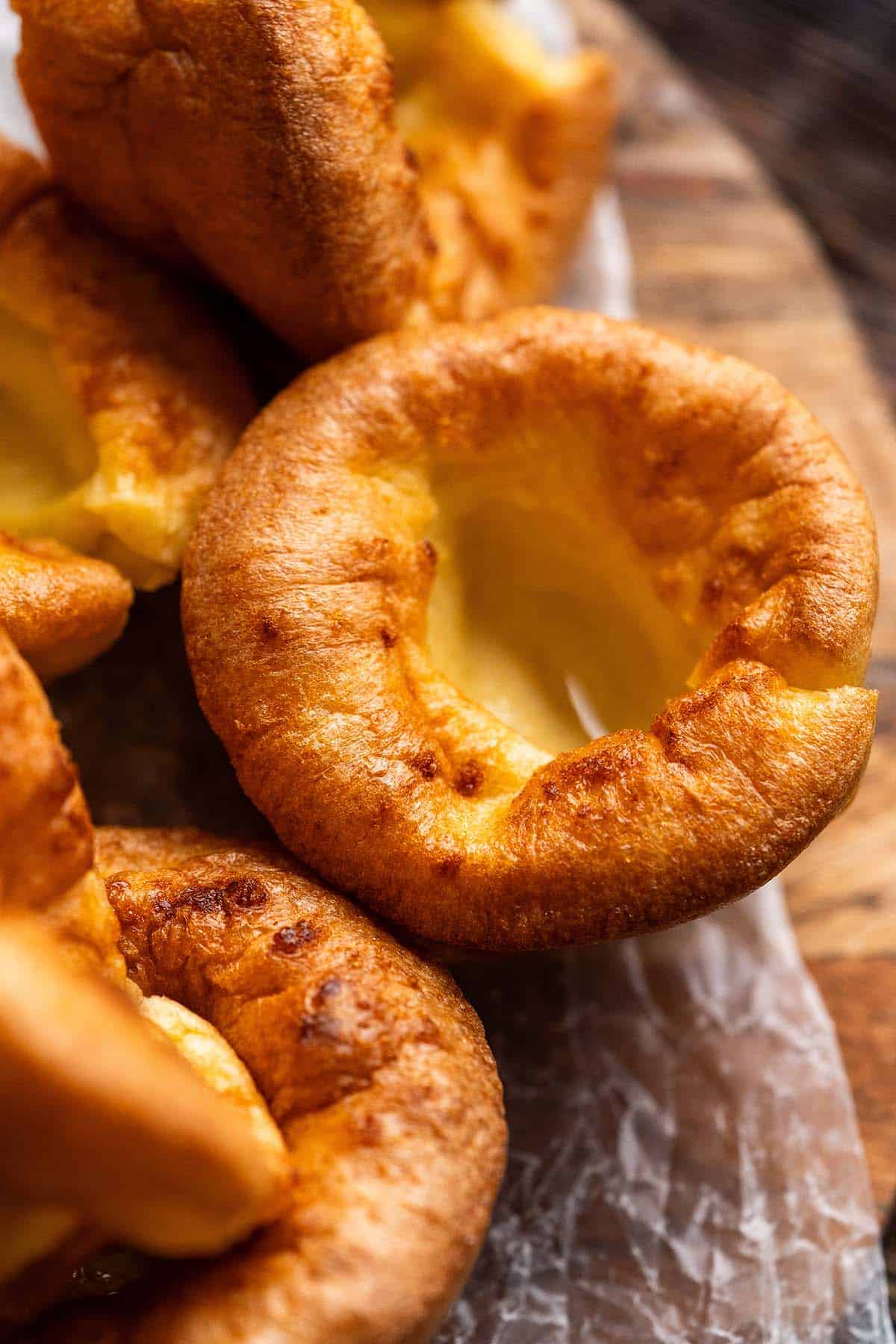
What is Yorkshire Pudding?
Hailing from Northern England, Yorkshire pudding is not at all what you might think if you're not familiar with it. For starters, it's savory instead of sweet. And it's crisp! At least on the outside, although the inside is light, soft, and airy.
Yorkshire puddings are made from a mixture of minimal ingredients: flour, egg, and milk or water. The resulting batter is thin, similar to a thin pancake batter or crêpe batter, which earned this pudding the name "batter pudding".
Traditionally, this batter was cooked on a fire below a beef roasting on a spit. The fat and juices from the cooking beef would drip down into the pudding, and they were served together. The beautiful thing was that nothing was wasted!
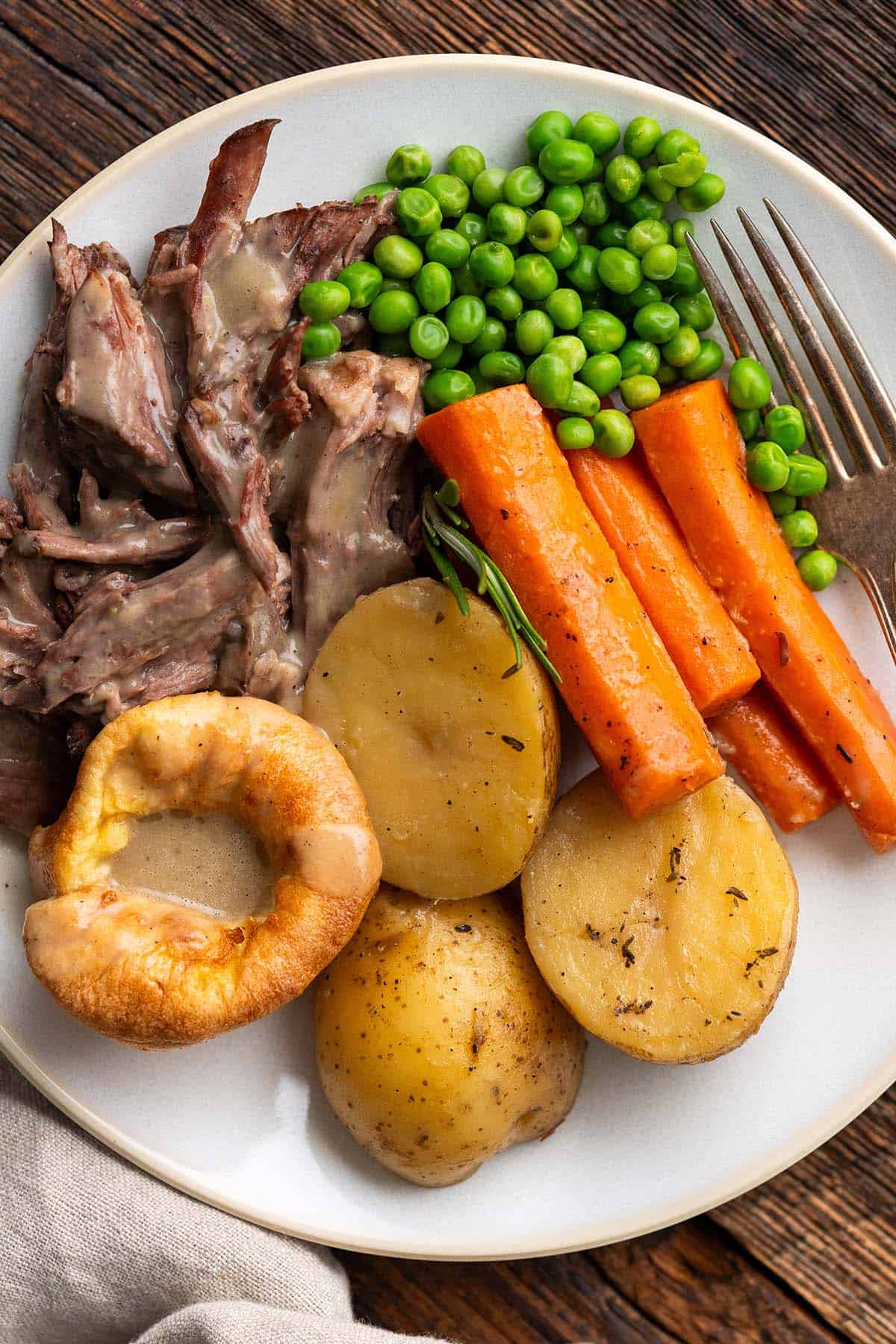
Originally, this pudding was cooked in a large shallow tin cut and served cut into squares. However, now it's common to see Yorkshire puddings cooked in what is referred to as a Yorkshire pudding tin. (But note that a muffin pan will work just fine.)
These deliciously crisp, golden puddings are light and airy inside, and bake up with a hollow interior and a natural cup shape. As such, they're perfect for serving along with gravy spooned inside. (Onion gravy is poplar in the UK!) And they're a classic part of a "British Sunday Roast".
You can read more about the history of Yorkshire pudding on Historic UK.

Yorkshire Pudding Ingredients and Substitutions
Ingredients Explained
In this section I explain the ingredients and give substitution ideas where applicable. For the full recipe (including the ingredient amounts), see the recipe card below.
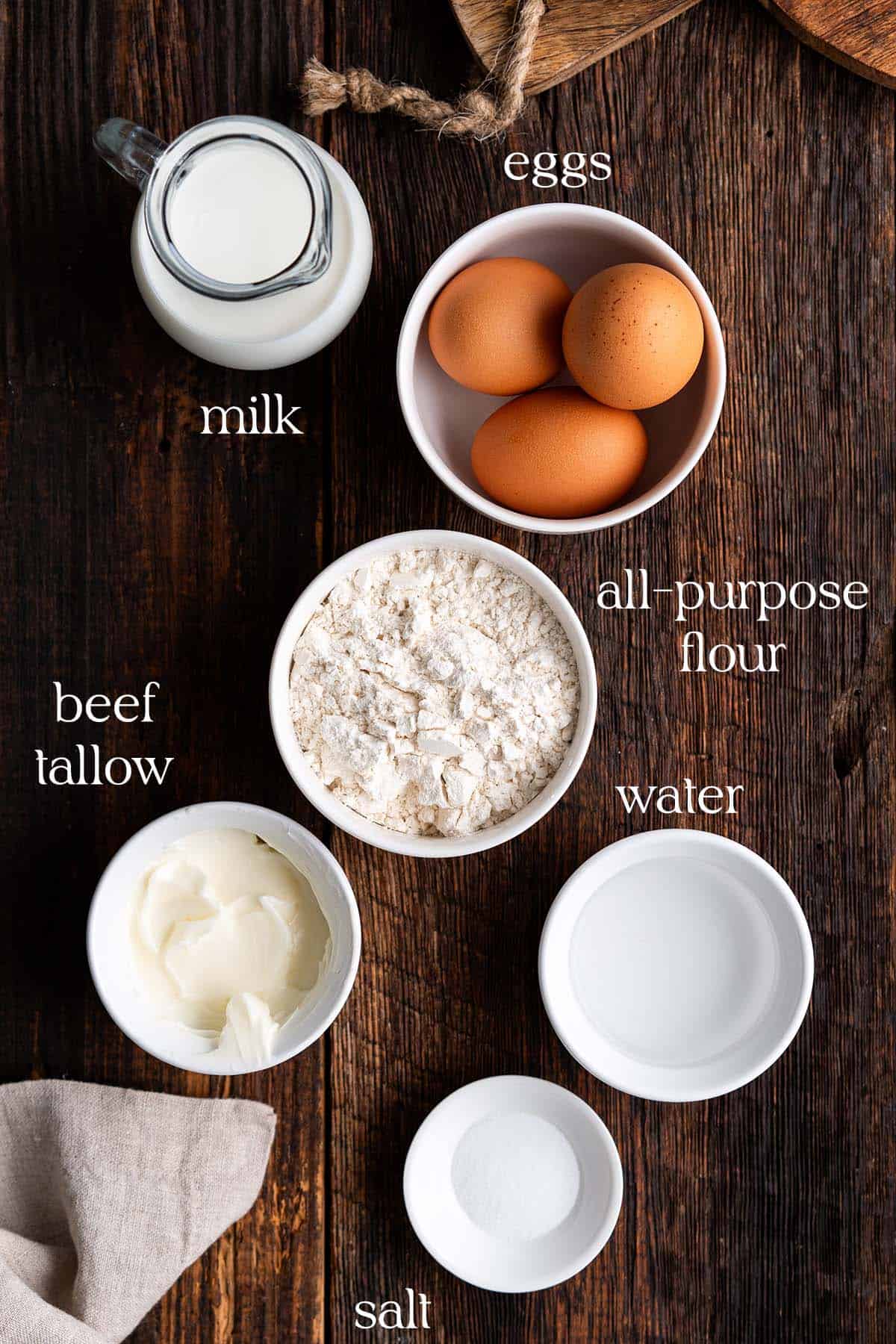
- Flour - Use regular all-purpose flour here.
- Salt - Salt is a natural flavor enhancer that ensures our savory puddings aren't bland.
- Eggs - Make sure the eggs are at room temperature.
- Milk - You can use whole milk, low-fat milk, or skim milk; make sure it's at room temperature.
- Water - We use a combination of milk and water because milk makes the puddings tender inside and water makes them crisp outside.
- Beef tallow - Beef tallow is rendered beef fat. Rendered fat is essentially fat that's cooked down to remove the water and strained to remove the impurities. To keep this recipe as close to traditional Yorkshire pudding as possible, I like to use beef tallow as the cooking fat. However, you can also use clarified butter (aka ghee) or strained bacon drippings (I've used drippings from beef bacon and these puddings turn out delicious). If you use bacon drippings, reduce the salt to ½ teaspoon.
Is Milk or Water Better in Yorkshire Pudding?

Milk creates tender puddings, while water makes puddings light and crisp. I find it's best to use a 3:1 ratio of milk:water to get the benefits of both.
How to Make Yorkshire Pudding
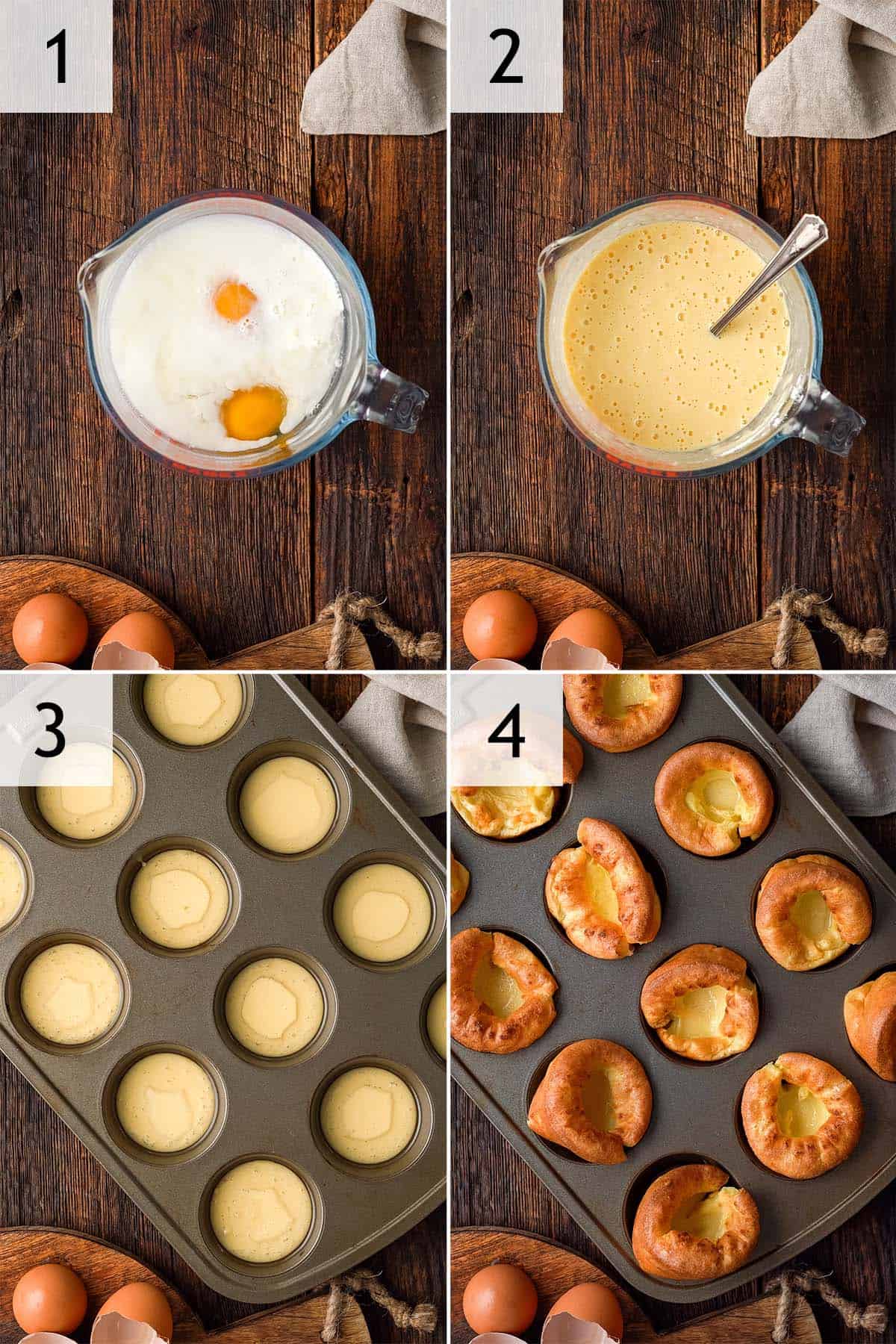
- Add the flour, salt, eggs, water, and milk to a medium bowl.
- Whisk to combine, being careful not to over-mix. You don’t want large patches of flour, but a few lumps are fine. Set the batter aside to rest (at room temperature) for 30 minutes.
- Once you start resting the batter, wait about 15 minutes and then preheat the oven to 450F. Use a 1-teaspoon scoop to measure 1 teaspoon of beef tallow into each of 12 muffin wells in a standard-sized muffin pan. Put the tray into the preheated oven until the fat is melted and screaming hot, about 10 minutes. Working carefully but as quickly as possible, fill each muffin well about halfway full with batter.
- Bake until the popovers are puffed and golden, about 15 to 20 minutes. For best results, don’t open the oven while they cook!
Storage and Reheating
I'm just going to come out and say it, friends. Yorkshire puddings are best when they're first made: blissfully crisp and golden outside, and soft and airy inside. If at all possible, I recommend timing your meal so that they're just coming out of the oven when you're ready to sit down to dinner. Otherwise, they lose the magic.
However, I know that sometimes life happens. If (on the off chance) you have leftovers, or if you're not able to sit down to dinner as soon as your Yorkies are ready, fear not.
You can store Yorkshire pudding covered in the fridge for up to 3 days. When you want to reheat them, start by letting the puddings sit at room temperature for 20 minutes. Once they're at room temperature, you can reheat Yorkshire puddings in a 400F oven until warm, about 3 to 5 minutes. Or you can reheat them in a 350F air fryer until warm, about 2 minutes. (I've also heard that Yorkshire pudding freezes well and that you can reheat it directly from frozen, but I haven't tried this myself!)
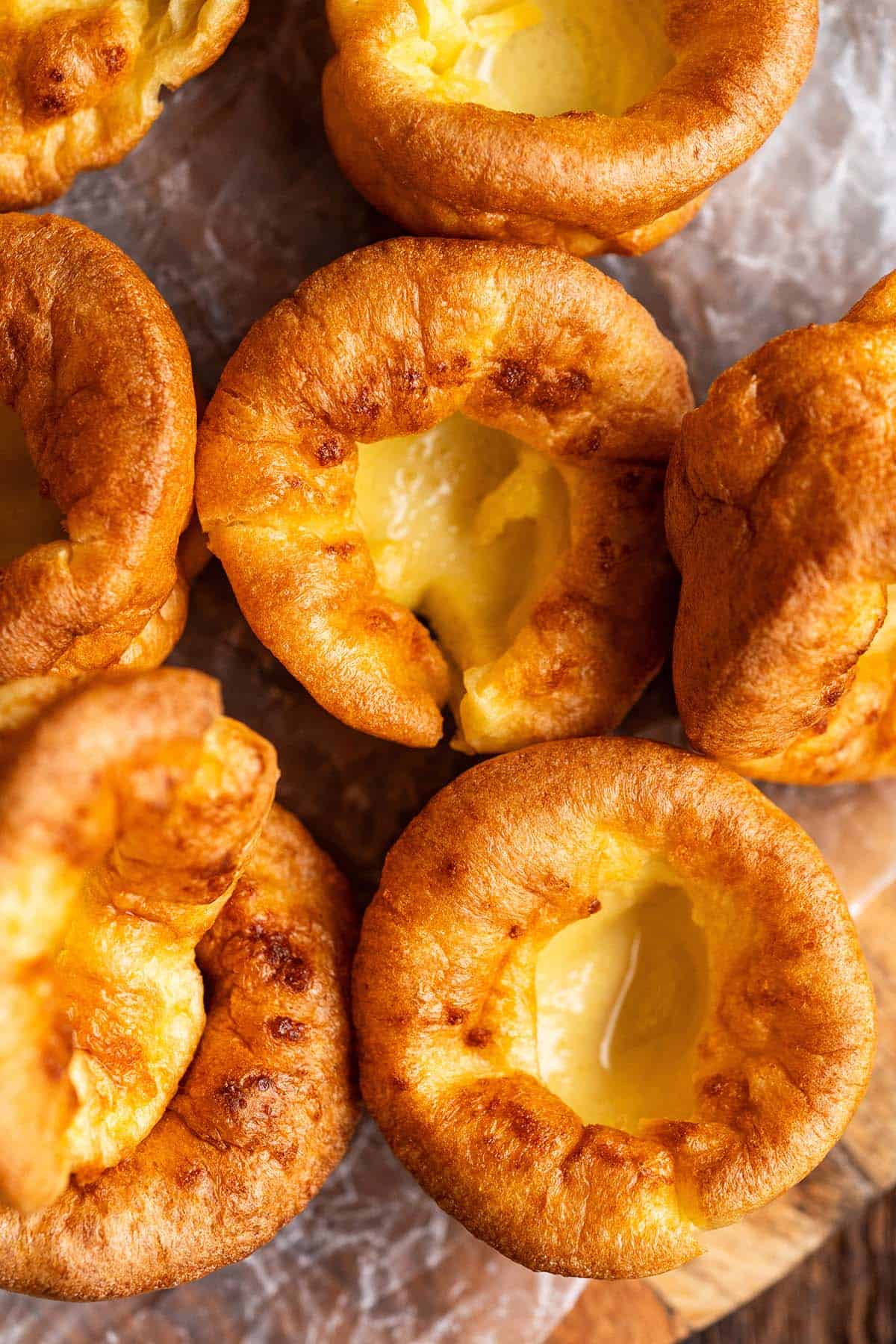
Yorkshire Pudding Recipe FAQs
What is Yorkshire Pudding Called in America?
To be completely honest, here in the U.S., we don't have Yorkshire pudding, exactly.
However, we do make things that are very similar. Namely, popovers and the Dutch baby. If you're not familiar with a Dutch baby, it's popover batter cooked in a cast-iron skillet or Dutch oven.
Are Popovers and Yorkshire Puddings the Same Thing?
No, they're not exactly the same.
On one hand, the batter for both is pretty much identical.
However, there are three differences between them that I know of:
- Cooking fat. Traditional Yorkshire puddings are made with the beef fat drippings from making a roast (earning them the name "dripping pudding"). On the other hand, popovers are typically made with butter. This is a big reason why Yorkies and popovers taste different even though they use the same batter. (Side Note: There's another recipe that uses the same batter! The British dish Toad in the Hole is Yorkshire pudding batter that's cooked in a larger dish with whole sausages, and is frequently served with onion gravy.)
- The pan. A popover pan looks like a muffin pan with deeper wells. On the other hand, a Yorkshire pudding pan sometimes has deep wells with angled sides that flare out at the top. I've also seen Yorkshire pudding tins that have shallow wells (similar to a muffin top pan).
- Serving. Interestingly enough, Yorkshire pud is always savory. It's usually served along with dinner or as a first course to dinner. On the other hand, popovers can be sweet or savory, and run the gamut of breakfast to dessert to dinner.
What is the Best Fat to Cook Yorkshire Puddings?
Traditional Yorkshire pudding recipes use rendered beef fat because they were served along with a beef roast (and cooked underneath it to catch the drippings). However, there are a few kinds of fat that work well, so you have options.
Note that we need an oil with a high smoke point (because we're baking these at a screaming hot temperature. Additionally, saturated fats, which are solid at room temperature, will yield a much crisper pudding.
Here are a few fats that work well for cooking Yorkshire puddings:
- Beef fat or beef tallow
- Duck fat
- Clarified butter (ghee)
- Bacon fat/drippings (strained) - I like to use beef bacon drippings

Is Yorkshire Pudding Sweet or Savory?
Traditional Yorkshire pudding is savoury. In England, it's typically served as an appetizer course or as part of the main course.
What Does Yorkshire Pudding Taste Like?
Outside it's crisp and golden, and inside it's light, fluffy, and airy. The crispy exterior takes the flavor of whatever fat you cook the puddings in. And the tender interior has a rich, eggy flavor that's similar to French pâte à choux (which you might recognize as the pastry for cream puffs, profiteroles, and éclairs!).
Can I Make Yorkshire Pudding Batter in Advance?
Yes! You can make the batter up to 24 hours ahead of time. Keep it covered in the fridge and let it sit at room temperature for 30 minutes before baking.
Can You Cook Yorkshire Puddings in Muffin Tins?
Absolutely. You can use regular, jumbo, or mini muffin tins to make Yorkies (but note that the bake time will vary for each). And a popover pan will work great too.
Or if you want a larger pud, you can go with a cast-iron skillet or Dutch oven.
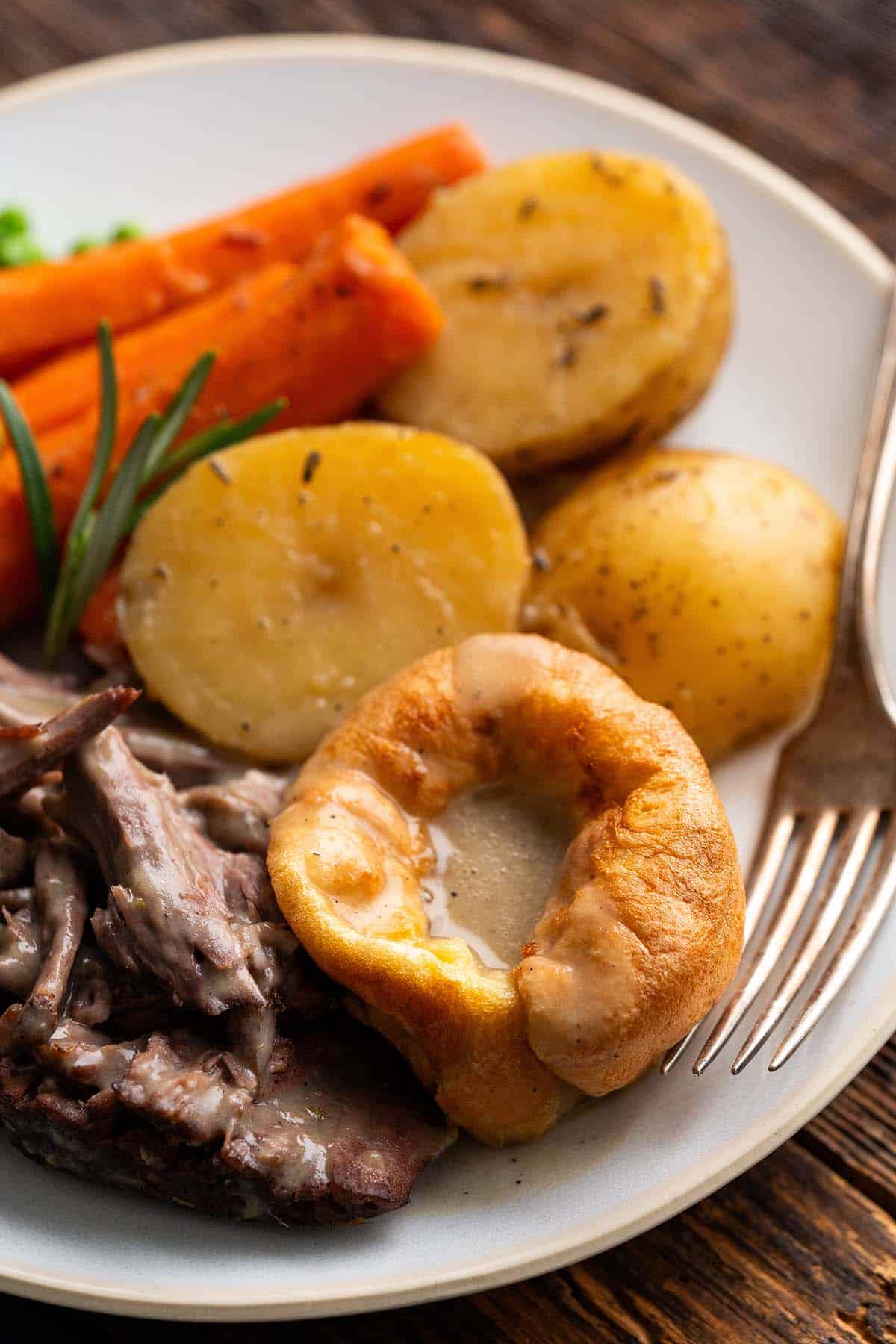
What Do You Serve with Yorkshire Pudding?
It's traditional to serve Yorkshires with a beef roast because:
- Yorkshire puddings were originally made using the beef fat that dripped off the roast as it cooked.
- The puddings cook up to perfect little cups that are great for serving with gravy ladled inside, or filled with meat and vegetables.
Here are a few good beef options that pair well with Yorkshire puddings:
- Crockpot Pot Roast Recipe
- Instant Pot Beef Short Ribs
- Easy Beef Stew Inspired by English Beef and Ale Stew
- Instant Pot Beef Tips and Gravy
More Easy Side Dishes to Serve with a Roast Dinner
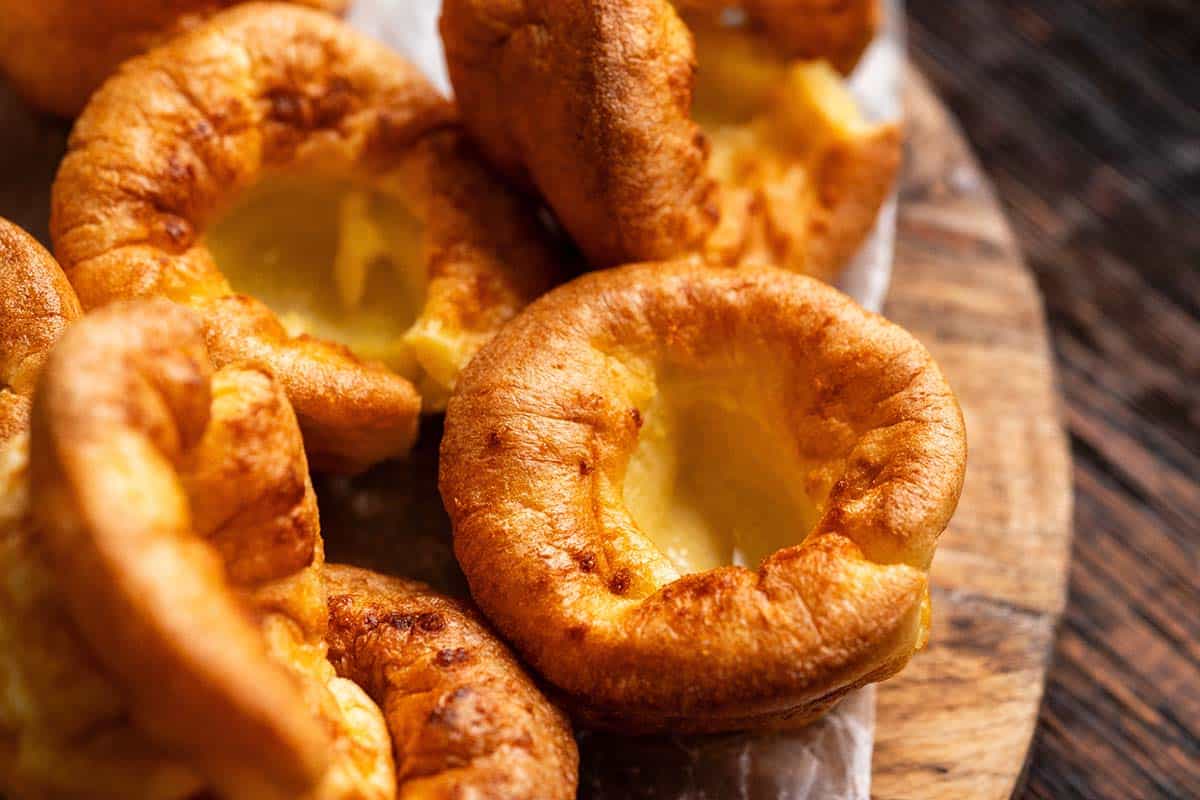
Let's Connect

Did you make this recipe? Please rate it and leave a comment below. You can also tag @anediblemosaic on social media.
To stay up-to-date, follow me on Facebook, Instagram, Pinterest, and Twitter!

Easy Yorkshire Pudding Recipe
Equipment
- Standard-size muffin pan see Notes
Ingredients
- 1 cup all-purpose flour
- 1 teaspoon salt
- 3 large eggs at room temperature
- ¼ cup water lukewarm or at room temperature
- ¾ cup whole milk at room temperature
- 12 teaspoons beef tallow see Notes
Instructions
- Add the flour, salt, eggs, water, and milk to a medium bowl and whisk to combine, being careful not to over-mix. You don’t want large patches of flour, but a few lumps are fine. Set the batter aside to rest (at room temperature) for 30 minutes. (See Notes.)
- Once you start resting the batter, wait about 15 minutes, and then preheat the oven to 450F.
- Use a 1-teaspoon scoop to measure 1 teaspoon of beef tallow into each of 12 muffin wells in a standard-sized muffin pan. Put the tray into the preheated oven until the fat is melted and screaming hot, about 10 minutes.
- Working carefully but as quickly as possible, fill each muffin well about halfway full with batter.
- Bake until the popovers are puffed and golden, about 15 to 20 minutes. For best results, don’t open the oven while they cook!
- Serve immediately.
Video
Faith's Tips
- Batter Rest Time: Instead of just letting it rest for 30 minutes, you can make the batter up to 24 hours ahead of time. Keep it covered in the fridge and let it sit at room temperature for 30 minutes before baking.
- Storage and Reheating: Yorkshire puddings are best when they're first made: blissfully crisp and golden outside, and soft and airy inside. If at all possible, I recommend timing your meal so that they're just coming out of the oven when you're ready to sit down to dinner. However, you can store Yorkshire pudding covered in the fridge for up to 3 days. Once they're at room temperature, you can reheat Yorkshire puddings in a 400F oven until warm, about 3 to 5 minutes. Or you can reheat them in a 350F air fryer until warm, about 2 minutes. (I've also heard that Yorkshire pudding freezes well and that you can reheat it directly from frozen, but I haven't tried this myself!)
- The Pan: A standard-size muffin tin will work perfectly well here, or you can get a Yorkshire pudding pan. Yorkshire pudding pans sometimes have deep wells with angled sides that flare out at the top. I've also seen Yorkshire pudding tins that have shallow wells (similar to a muffin top pan).
- Fats That Work Well For Yorkshire Puddings: If you don't want to use beef drippings or beef tallow, you can use duck fat, clarified butter (ghee), or bacon fat/drippings (strained). I've had good results with beef bacon drippings!
Nutrition
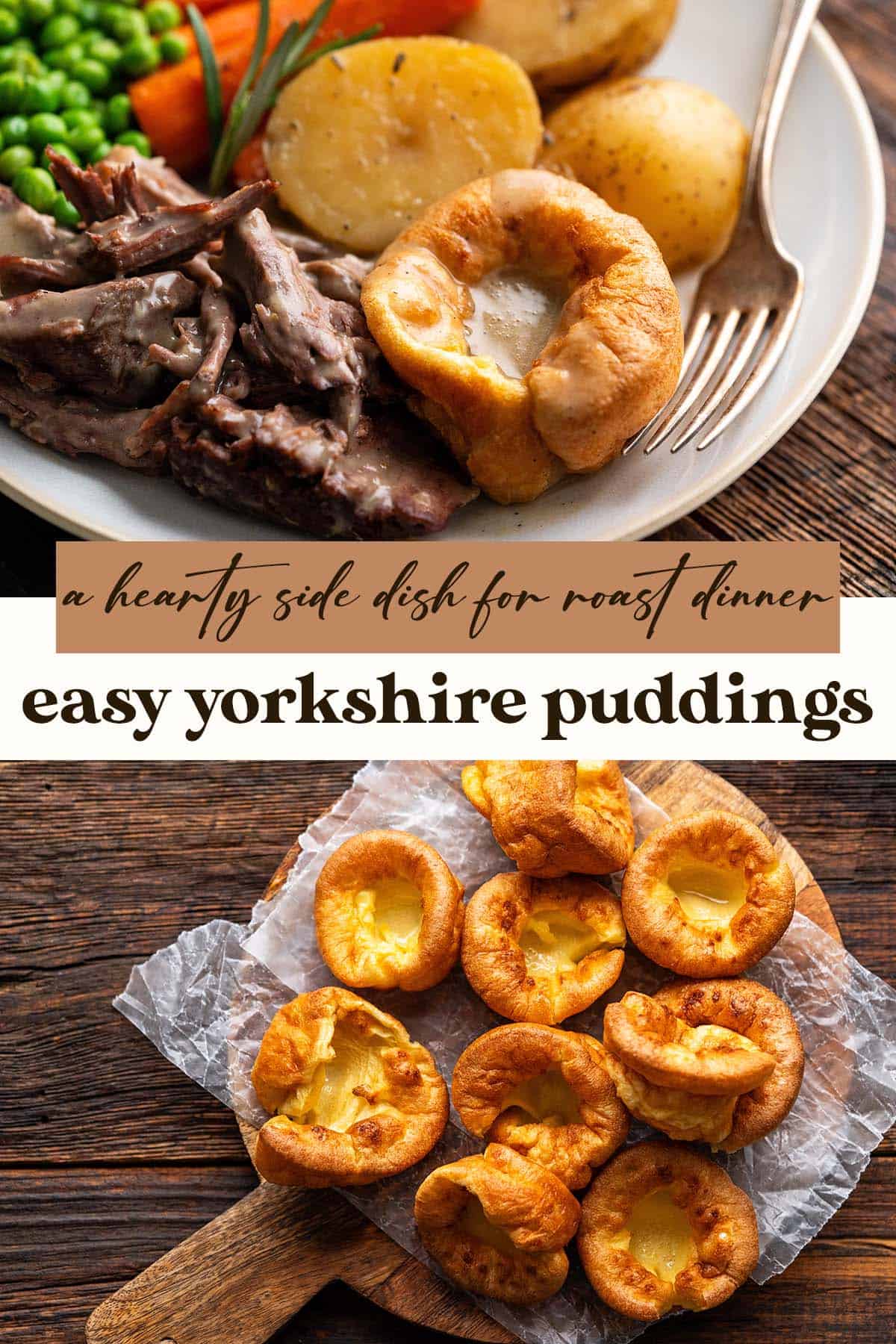

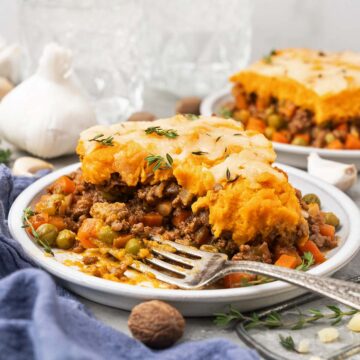
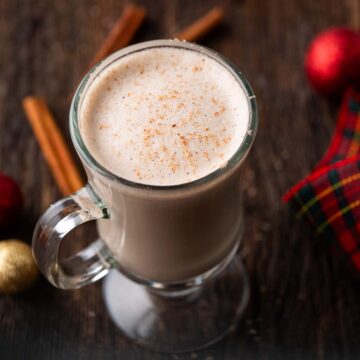
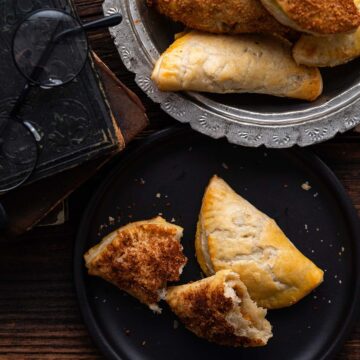
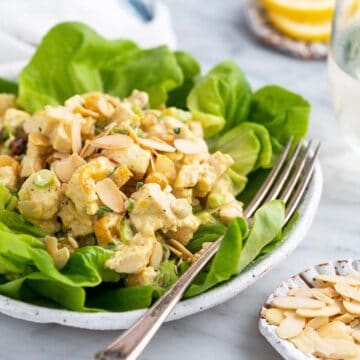
Leave a Reply